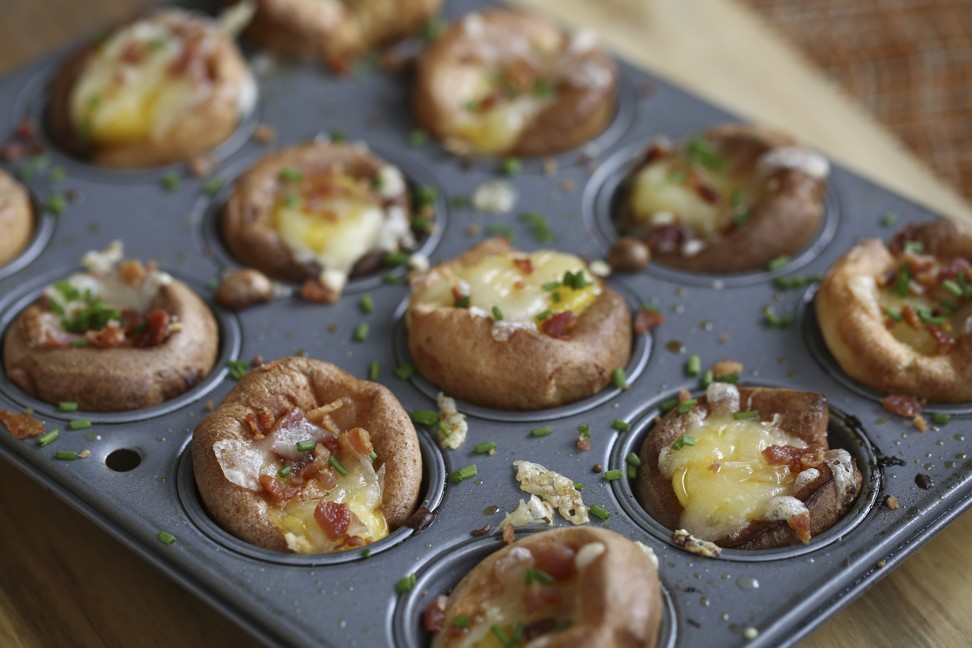
Two simple recipes for pre-dinner snacks, best served with a refreshing summer cocktail
- Learn how to make Susan Jung’s take on popovers, complete with bacon, cheese and quail egg
- Plus, an easy tapenade-based light bite that delivers on flavour
These two easy dishes are great to serve to guests as a pre-dinner snack with a glass of champagne, wine, sangria or a summery cocktail.
With the first recipe, most of the work can be done in advance. Cook the bacon, grate the cheese and pre-bake the popovers (or Yorkshire puddings, as they are known in some parts of the world). About 10 minutes before you want to serve them, add the bacon, egg yolk and grated cheese into the popovers and bake them briefly. Keeping in mind guests who might not like runny eggs, I bake half the popovers with egg and the rest without.
With the second recipe, make the tapenade in advance, then toast the bread just before you plan to serve the crostini.
Twice-cooked popovers with bacon, cheese and quail egg
The basic popover recipe is adapted from one for Yorkshire pudding on seriouseats.com. The batter should be made at least four hours before you want to bake the popovers. It is even better if you let the batter rest overnight in the fridge. The batter should be brought back to room temperature before baking.
2 large eggs
75 grams plain (all-purpose) flour
85ml whole milk
15ml water
½ tsp fine sea salt
6-8 rashers of streaky bacon
About 100 grams aged comté
12-24 quail eggs

1 Crack the eggs into a bowl and whisk with the salt. Add the flour and whisk – it will be very thick. Mix in about 30ml of milk and whisk until smooth. Add another 30ml of milk, again whisking until smooth. Pour in the water and remaining milk, then whisk again. Scrape the mixture into a container with a pouring spout and refrigerate for at least four hours, or overnight.
2 Heat an unoiled skillet over a medium flame, add the bacon and cook until pale golden, turning the pieces over as needed. Drain the bacon on paper towels, then chop into 5mm-wide pieces. Reserve the bacon fat. Grate the cheese.
3 Take the container holding the batter from the fridge and let it rest at room temperature for about an hour. Divide 60ml of the bacon fat between two mini-muffin tins that have 12 hollows each, and which hold about 30ml per hollow. Place the muffin tins in the oven on two racks. Preheat the oven to 230 degrees Celsius.

4 Stir the batter gently, then pour it into the hot muffin tins, adding enough so each hollow is one-third full. Immediately place the tins back in the oven and bake undisturbed for 10 minutes. The popovers should be medium-brown and well risen with a deep well in the centre; if not, let them cook undisturbed for another minute or two.
Quickly and carefully, turn the tins around in the oven and let them continue to bake until fully cooked – they will be fragrant and firm to the touch. Take them from the oven and let them cool to room temperature.
5 About 30 minutes before you want to bake the popovers a second time, heat the oven to 200 degrees.

6 When the oven is hot, divide the bacon between the popovers. Crack the quail eggs into a shallow dish, then use a spoon to scoop out the yolk (leaving behind the white) and place it in the centre of each popover.
Put a large pinch of cheese over the yolk to cover it completely (if not using quail eggs, add enough cheese to cover the bacon). Place the tins in the oven and bake for five minutes (for a runny yolk) to eight minutes (for a firmer yolk). Serve immediately.

Tapenade crostini
Having a jar of tapenade in the fridge means you can whip up dishes without much effort – use it as a dip for raw or blanched vegetables, or spread a layer of it over a piece of grilled fish.
This dish is adapted from a recipe in The Food of France (2001), by Maria Villegas. Use top-quality, unpitted olives, not the tasteless ones that come in cans.
300 grams black olives, preferably Nicoise
25 grams drained capers
6-8 anchovy fillets in olive oil, drained
1 large garlic clove
180ml extra-virgin olive oil, plus extra for drizzling on the baguette slices
10 grams Dijon mustard
1 sprig fresh thyme
1 large sprig fresh parsley
1 baguette
1Place the olives on a cutting board, press on them firmly with the side of a knife and roll them slightly while pressing. This loosens the pit. Remove and discard the pits and put the flesh into a food processor.
2 Put the drained capers on a paper towel, cover with another paper towel and press lightly to remove the excess moisture. Add the capers to the olives in the food processor. Roughly chop the anchovy fillets and the garlic, add them to the olives and capers and process briefly. Mix in the mustard and 180ml of olive oil. Pull the thyme and parsley leaves from the stalks and add them to the processor. Process the ingredients into a rough paste.
3 Preheat the grill/broiler in the oven. Cut the baguette on the diagonal into 5mm-thick slices. Lay the slices on a baking tray and drizzle both sides with olive oil. Slide the tray under the grill/broiler so the baguette slices are about 2cm away from the heating element. Toast the bread, watching it carefully. Turn over the pieces as they brown and toast the other side; remove the slices as they are ready.
4 Spread a layer of the tapenade over the bread and serve.

